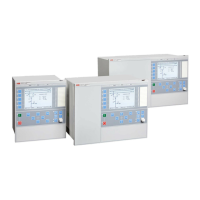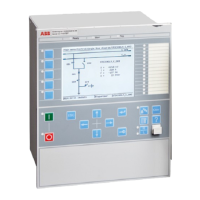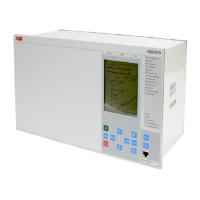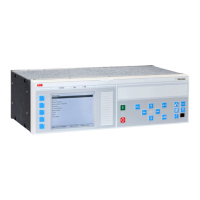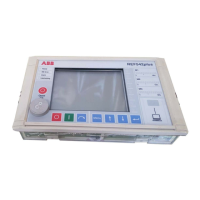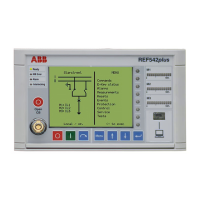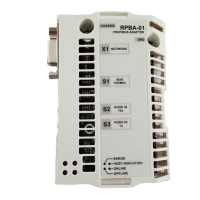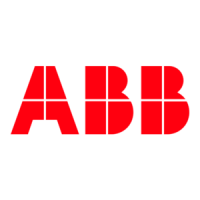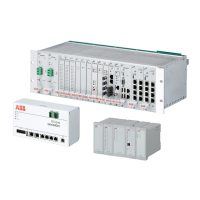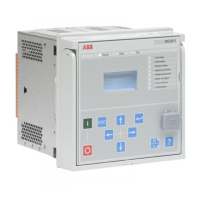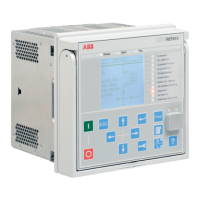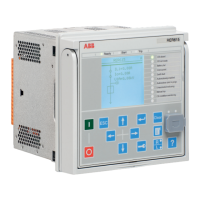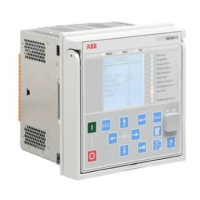Section 2 REC615 and RER615 overview Page: 29 Overview Introduces REC615 and RER615 relays, their design guided by IEC 61850, and supported communication protocols.
Local HMI Describes the Local Human-Machine Interface (LHMI) components: display, buttons, LEDs, and communication port.
Web HMI Explains the Web HMI for secure access, its functions, and browser compatibility.
Authorization Details the four predefined user categories (VIEWER, OPERATOR, ENGINEER, ADMINISTRATOR) with their rights.
Audit trail Describes the event logging functions for security-related events, storing critical system and relay events.
Communication Outlines communication protocols like IEC 61850, GOOSE, and Ethernet connections.
Ethernet redundancy Details network redundancy schemes like PRP and HSR protocols for improved system availability.
Process bus Describes Process bus IEC 61850-9-2 for Sampled Measured Values transmission.
Secure communication Explains secure communication for WHMI and file transfer using TLS-based encryption (HTTPS, FTPS).
Section 3 Basic functions Page: 45 Self-supervision Details the relay's self-supervision system, covering internal faults and warnings.
LED indication control Describes the LED indication control using the LEDPTRC function block and its functionality.
Programmable LEDs Explains the functionality, function block, and signals of the programmable LEDs on the LHMI.
Time synchronization Details time synchronization methods including internal clock, external sources, and supported protocols.
Parameter setting groups Explains the support for six setting groups and how to change the active setting group at run time.
Test mode Describes the operation modes for testing: Normal, IED blocked, IED test, and IED test and blocked.
Control mode Details how logical nodes under CTRL can be set using Control mode parameter, inherited from Test mode.
Authorization Details the predefined user categories (VIEWER, OPERATOR, ENGINEER, ADMINISTRATOR) with their rights.
Audit trail Describes the event logging functions for security-related events, storing critical system and relay events.
Communication Outlines communication protocols like IEC 61850, GOOSE, and Ethernet connections.
Ethernet redundancy Details network redundancy schemes like PRP and HSR protocols for improved system availability.
Process bus Describes Process bus IEC 61850-9-2 for Sampled Measured Values transmission.
Secure communication Explains secure communication for WHMI and file transfer using TLS-based encryption (HTTPS, FTPS).
LEDs Describes the LHMI LEDs: Ready, Start, Trip, and the 11 matrix programmable LEDs.
Keypad Explains the LHMI keypad functions for navigation, commands, and interaction.
Fault recorder FLTRFRC Details the fault recorder function, including capacity, recording period, and data format.
Binary input Explains binary input filtering time and inversion parameters.
Binary outputs Describes the types of binary outputs: power output contacts and signal output contacts.
Programmable LEDs Explains the functionality, function block, and signals of the programmable LEDs on the LHMI.
Time synchronization Details time synchronization methods including internal clock, external sources, and supported protocols.
Parameter setting groups Explains the support for six setting groups and how to change the active setting group at run time.
Test mode Describes the operation modes for testing: Normal, IED blocked, IED test, and IED test and blocked.
Control mode Details how logical nodes under CTRL can be set using Control mode parameter, inherited from Test mode.
Section 4 Protection functions Page: 201 Earth-fault protection Covers non-directional and directional earth-fault protection functions, including identification, function blocks, and operation principles.
Unbalance protection Covers negative-sequence overcurrent protection (NSPTOC) and positive-sequence undervoltage protection (PSPTUV).
Voltage protection Covers three-phase overvoltage protection (PHPTOV) and three-phase undervoltage protection (PHPTUV).
Frequency protection FRPFRQ Explains the frequency protection function, including overfrequency, underfrequency, and rate-of-change detection.
Power protection Covers three-phase power directional element (DPSRDIR) and multipurpose protection (MAPGAPC).
Protection related functions Details functions related to protection, including inrush detector, circuit breaker failure protection, and fault locator.
Master trip TRPPTRC Explains the master trip function as a trip command collector and handler for protection functions.
Fault locator SCEFRFLO Describes the impedance-based fault location function, its operation principle, and application.
Section 14 Technical data Page: 781 Dimensions Provides dimensions (Width, Height, Depth) and weight of the protection relay.
Power supply Details nominal auxiliary voltage, maximum interruption time, and auxiliary voltage variation.
Energizing inputs Lists energizing input specifications for current and voltage sensors, including rated values and withstand.
Binary inputs Details binary input specifications like values, unit, step, default, and description.
Environmental conditions Lists operating, short-time service, and storage temperature ranges, humidity, atmospheric pressure, and altitude.
Product safety References LV directive and standards for product safety.
EMC compliance References EMC council directive and standard for EMC compliance.
Section 17 Glossary Page: 793 100 BASE-FX Defines 100BASE-FX as an Ethernet standard for LANs using fiber optic cabling.
100 BASE-TX Defines 100BASE-TX as an Ethernet standard for LANs using twisted-pair cabling.
ACT Application Configuration tool in PCM600, or Trip status in IEC 61850.
CAT 5 A twisted pair cable type designed for high signal integrity.
CAT 5 e An enhanced version of CAT 5 that adds specifications for far end crosstalk.
COMTRADE Common format for transient data exchange for power systems, defined by IEEE Standard.
CPU Central processing unit.
DC 1. Direct current, 2. Disconnector, 3. Double command.
DFT Discrete Fourier transform.
DHCP Dynamic Host Configuration Protocol.
DNP3 A distributed network protocol developed by Westronic for communication in PLCs and RTU devices.
EEPROM Electrically erasable programmable read-only memory.
EIA-232 Serial communication standard according to Electronics Industries Association.
EIA-485 Serial communication standard according to Electronics Industries Association.
EMC Electromagnetic compatibility.
Ethernet A standard for connecting computer networking technologies into a LAN.
FPGA Field-programmable gate array.
FTP File transfer protocol.
GFC General fault criteria.
GOOSE Generic Object-Oriented Substation Event.
GPS Global Positioning System.
HMI Human-machine interface.
HSR High-availability seamless redundancy.
HTTPS Hypertext Transfer Protocol Secure.
IDMT Inverse definite minimum time.
IEC International Electrotechnical Commission.
IEC 61850 International standard for substation communication and modeling.
IEC 61850-8-1 A communication protocol based on the IEC 61850 standard series.
IEC 61850-9-2 A communication protocol based on the IEC 61850 standard series.
IEEE 1686 Standard for Substation Intelligent Electronic Devices' (IEDs') Cyber Security Capabilities.
IP address A set of four numbers separated by periods, specifying the location for the TCP/IP protocol.
IRF 1. Internal fault, 2. Internal relay fault.
IRIG-B Inter-Range Instrumentation Group's time code format B.
LC Connector type for glass fiber cable, IEC 61754-20.
LCD Liquid crystal display.
LHMI Local human-machine interface.
MCB Miniature circuit breaker.
MMS 1. Manufacturing message specification, 2. Metering management system.
Modbus A serial communication protocol developed by Modicon for PLCs and RTU devices.
P2 P 1. Personal computer, 2. Polycarbonate.
PC 1. Personal computer, 2. Polycarbonate.
PCM600 Protection and Control IED Manager.
Peak-to-peak 1. Amplitude between max positive and negative values. 2. Measures average from peak values, excluding DC component.
PLC Programmable logic controller.
PRP Parallel redundancy protocol.
PTP Precision Time Protocol.
RCA Also known as MTA or base angle. Characteristic angle.
RJ-45 Galvanic connector type.
RMS Root-mean-square (value).
RSTP Rapid spanning tree protocol.
RTD Resistance temperature detector.
SBO Select-before-operate.
SCADA Supervision, control and data acquisition.
SCL XML-based substation description configuration language defined by IEC 61850.
SMT Signal Matrix tool in PCM600.
SMV Sampled measured values.
SNTP Simple Network Time Protocol.
ST Connector type for glass fiber cable.
TCP;IP Transmission Control Protocol/Internet Protocol.
TCS Trip-circuit supervision.
UTC Coordinated universal time.
WHMI Web human-machine interface.
Section 2 REC615 and RER615 overview Page: 29 Overview Introduces REC615 and RER615 relays, their design guided by IEC 61850, and supported communication protocols.
Local HMI Describes the Local Human-Machine Interface (LHMI) components: display, buttons, LEDs, and communication port.
Web HMI Explains the Web HMI for secure access, its functions, and browser compatibility.
Authorization Details the four predefined user categories (VIEWER, OPERATOR, ENGINEER, ADMINISTRATOR) with their rights.
Audit trail Describes the event logging functions for security-related events, storing critical system and relay events.
Communication Outlines communication protocols like IEC 61850, GOOSE, and Ethernet connections.
Ethernet redundancy Details network redundancy schemes like PRP and HSR protocols for improved system availability.
Process bus Describes Process bus IEC 61850-9-2 for Sampled Measured Values transmission.
Secure communication Explains secure communication for WHMI and file transfer using TLS-based encryption (HTTPS, FTPS).
Section 3 Basic functions Page: 45 Self-supervision Details the relay's self-supervision system, covering internal faults and warnings.
LED indication control Describes the LED indication control using the LEDPTRC function block and its functionality.
Programmable LEDs Explains the functionality, function block, and signals of the programmable LEDs on the LHMI.
Time synchronization Details time synchronization methods including internal clock, external sources, and supported protocols.
Parameter setting groups Explains the support for six setting groups and how to change the active setting group at run time.
Test mode Describes the operation modes for testing: Normal, IED blocked, IED test, and IED test and blocked.
Control mode Details how logical nodes under CTRL can be set using Control mode parameter, inherited from Test mode.
Authorization Details the predefined user categories (VIEWER, OPERATOR, ENGINEER, ADMINISTRATOR) with their rights.
Audit trail Describes the event logging functions for security-related events, storing critical system and relay events.
Communication Outlines communication protocols like IEC 61850, GOOSE, and Ethernet connections.
Ethernet redundancy Details network redundancy schemes like PRP and HSR protocols for improved system availability.
Process bus Describes Process bus IEC 61850-9-2 for Sampled Measured Values transmission.
Secure communication Explains secure communication for WHMI and file transfer using TLS-based encryption (HTTPS, FTPS).
LEDs Describes the LHMI LEDs: Ready, Start, Trip, and the 11 matrix programmable LEDs.
Keypad Explains the LHMI keypad functions for navigation, commands, and interaction.
Fault recorder FLTRFRC Details the fault recorder function, including capacity, recording period, and data format.
Binary input Explains binary input filtering time and inversion parameters.
Binary outputs Describes the types of binary outputs: power output contacts and signal output contacts.
Programmable LEDs Explains the functionality, function block, and signals of the programmable LEDs on the LHMI.
Time synchronization Details time synchronization methods including internal clock, external sources, and supported protocols.
Parameter setting groups Explains the support for six setting groups and how to change the active setting group at run time.
Test mode Describes the operation modes for testing: Normal, IED blocked, IED test, and IED test and blocked.
Control mode Details how logical nodes under CTRL can be set using Control mode parameter, inherited from Test mode.
Section 4 Protection functions Page: 201 Earth-fault protection Covers non-directional and directional earth-fault protection functions, including identification, function blocks, and operation principles.
Unbalance protection Covers negative-sequence overcurrent protection (NSPTOC) and positive-sequence undervoltage protection (PSPTUV).
Voltage protection Covers three-phase overvoltage protection (PHPTOV) and three-phase undervoltage protection (PHPTUV).
Frequency protection FRPFRQ Explains the frequency protection function, including overfrequency, underfrequency, and rate-of-change detection.
Power protection Covers three-phase power directional element (DPSRDIR) and multipurpose protection (MAPGAPC).
Protection related functions Details functions related to protection, including inrush detector, circuit breaker failure protection, and fault locator.
Master trip TRPPTRC Explains the master trip function as a trip command collector and handler for protection functions.
Fault locator SCEFRFLO Describes the impedance-based fault location function, its operation principle, and application.
Section 14 Technical data Page: 781 Dimensions Provides dimensions (Width, Height, Depth) and weight of the protection relay.
Power supply Details nominal auxiliary voltage, maximum interruption time, and auxiliary voltage variation.
Energizing inputs Lists energizing input specifications for current and voltage sensors, including rated values and withstand.
Binary inputs Details binary input specifications like values, unit, step, default, and description.
Environmental conditions Lists operating, short-time service, and storage temperature ranges, humidity, atmospheric pressure, and altitude.
Product safety References LV directive and standards for product safety.
EMC compliance References EMC council directive and standard for EMC compliance.
Section 17 Glossary Page: 793 100 BASE-FX Defines 100BASE-FX as an Ethernet standard for LANs using fiber optic cabling.
100 BASE-TX Defines 100BASE-TX as an Ethernet standard for LANs using twisted-pair cabling.
ACT Application Configuration tool in PCM600, or Trip status in IEC 61850.
CAT 5 A twisted pair cable type designed for high signal integrity.
CAT 5 e An enhanced version of CAT 5 that adds specifications for far end crosstalk.
COMTRADE Common format for transient data exchange for power systems, defined by IEEE Standard.
CPU Central processing unit.
DC 1. Direct current, 2. Disconnector, 3. Double command.
DFT Discrete Fourier transform.
DHCP Dynamic Host Configuration Protocol.
DNP3 A distributed network protocol developed by Westronic for communication in PLCs and RTU devices.
EEPROM Electrically erasable programmable read-only memory.
EIA-232 Serial communication standard according to Electronics Industries Association.
EIA-485 Serial communication standard according to Electronics Industries Association.
EMC Electromagnetic compatibility.
Ethernet A standard for connecting computer networking technologies into a LAN.
FPGA Field-programmable gate array.
FTP File transfer protocol.
GFC General fault criteria.
GOOSE Generic Object-Oriented Substation Event.
GPS Global Positioning System.
HMI Human-machine interface.
HSR High-availability seamless redundancy.
HTTPS Hypertext Transfer Protocol Secure.
IDMT Inverse definite minimum time.
IEC International Electrotechnical Commission.
IEC 61850 International standard for substation communication and modeling.
IEC 61850-8-1 A communication protocol based on the IEC 61850 standard series.
IEC 61850-9-2 A communication protocol based on the IEC 61850 standard series.
IEEE 1686 Standard for Substation Intelligent Electronic Devices' (IEDs') Cyber Security Capabilities.
IP address A set of four numbers separated by periods, specifying the location for the TCP/IP protocol.
IRF 1. Internal fault, 2. Internal relay fault.
IRIG-B Inter-Range Instrumentation Group's time code format B.
LC Connector type for glass fiber cable, IEC 61754-20.
LCD Liquid crystal display.
LHMI Local human-machine interface.
MCB Miniature circuit breaker.
MMS 1. Manufacturing message specification, 2. Metering management system.
Modbus A serial communication protocol developed by Modicon for PLCs and RTU devices.
P2 P 1. Personal computer, 2. Polycarbonate.
PC 1. Personal computer, 2. Polycarbonate.
PCM600 Protection and Control IED Manager.
Peak-to-peak 1. Amplitude between max positive and negative values. 2. Measures average from peak values, excluding DC component.
PLC Programmable logic controller.
PRP Parallel redundancy protocol.
PTP Precision Time Protocol.
RCA Also known as MTA or base angle. Characteristic angle.
RJ-45 Galvanic connector type.
RMS Root-mean-square (value).
RSTP Rapid spanning tree protocol.
RTD Resistance temperature detector.
SBO Select-before-operate.
SCADA Supervision, control and data acquisition.
SCL XML-based substation description configuration language defined by IEC 61850.
SMT Signal Matrix tool in PCM600.
SMV Sampled measured values.
SNTP Simple Network Time Protocol.
ST Connector type for glass fiber cable.
TCP;IP Transmission Control Protocol/Internet Protocol.
TCS Trip-circuit supervision.
UTC Coordinated universal time.
WHMI Web human-machine interface.
